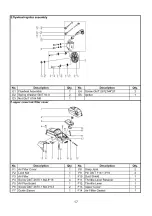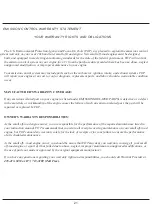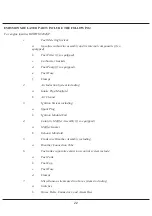
7
Overcutting
is when the bottom of
the saw is against the top of the log.
Use a light, downward pressure
when overcutting.
Undercutting
is when the log is cut
from the underside with the top of the
saw against the log. Use a light
upward pressure. Hold the saw firmly
and maintain control of the saw
because it will tend to push
backwards.
DO NOT turn the saw upside down
to undercut. Control of the saw
cannot be maintained in this position.
Always make your first cut on the
compression side of the log (where
the pressure of the log’s weight is
concentrated).
Bucking Without A Support
Using an overcut, cut through 1/3 the
diameter of the log.
Roll the log over and finish with a
second overcut.
Watch out for logs with a
compression side to prevent the saw
from being pinched.
Bucking Using A Log or Support
Stand
Make your first cut on the
compression side of the log and
extend it 1/3 into the diameter of the
log. Finish with a second cut.
Limbing and Pruning
WARNING: Be on alert for kickback.
Keep the moving chain away from
any other branches or objects when
limbing or pruning. Never climb into a
tree to limb or prune. Do not stand on
ladders, platforms, other logs or in a
position with unsteady footing.
Important Safety Reminders
Work slowly with both hands
gripping the saw. Maintain balance
and a secure footing.
Use caution when cutting smaller
limbs. Small limbs may catch in the
chain and be flung towards you or
throw you off balance.
Watch out for branches that are
under pressure or bent. When the
wood is cut, the tension may cause
the wood to be flung.
Keep your work area clear. Clear
away branches from the work area
in order to avoid tripping over them.
Limbing
Limbing should only be done when a
tree is already cut down.
Leave any large limbs under the tree
for support as you work.
Start at the base of the tree and
work towards the top. Small limbs
can be removed in one cut.
Keep the tree between you and the
chain. Cut opposite from the branch
being cut.
Remove any larger, supportive
branches with the technique
described in Bucking Without A
Support.
Always use an overcut to cut small
and free hanging limbs. Do not use
an undercut because it may cause
limbs to fall and pinch the saw.
Pruning
WARNING:
Do not prune limbs that
are above shoulder height. If the
branches are higher than your
shoulder, have a professional
perform the job.
Make your first cut 1/3 of the way
through the limb.
Make the second cut all the way
through the limb. The cut a third
overcut through the branch, leaving
a 1 – 2 inch collar from the trunk of
the tree.
MAINTENANCE
Maintenance Schedule
Check before each use:
Fuel mixture level
Bar lubrication
Chain tension
Chain sharpness
For damaged parts
For loose caps, fasteners and parts
Inspect and Clean
Bar:
Before each use
Saw:
After each use
Air filter:
Every 5 hours of use
Chain brake:
Every 5 hours of use
Spark arresting screen and
muffler:
Every 25 hours of use
Replace spark plug:
Yearly
Replace fuel filter:
Yearly
Maintenance Safety Instructions
1) Be sure to have your chainsaw
regularly serviced by a qualified
dealer.
2) Never modify the chainsaw in any
way.
3) Keep the handles clean and dry,
and free from oil or fuel.
4) Make sure the fuel and oil caps,
fasteners and screws are tightened
and secure after performing
maintenance.
5) Always wear protective gloves
when performing maintenance.
6) Do not perform maintenance
while the engine is hot.
Summary of Contents for 20120
Page 13: ...13 Parts List...
Page 14: ...14...
Page 15: ...15...
Page 16: ...16...
Page 17: ...17...
Page 18: ...18...
Page 19: ...19...








































